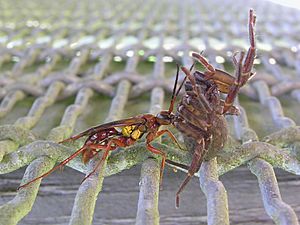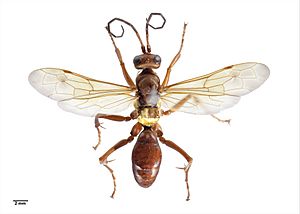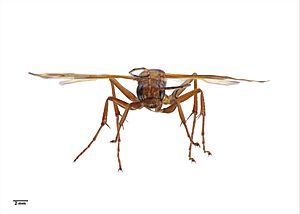Golden hunter wasp facts for kids
Quick facts for kids Sphictostethus nitidus |
|
|---|---|
 |
|
| Scientific classification | |
| Synonyms | |
|
The golden hunter wasp or red spider wasp (scientific name: Sphictostethus nitidus) is a special type of spider wasp found only in New Zealand. It's part of a group called pepsid wasps.
Contents
About the Golden Hunter Wasp
Female golden hunter wasps are reddish-brown with yellow hints and some dark spots. Males are also reddish-brown with yellow-tinted wings, but they don't have spots. Females can be from about 8.5 to 22 millimeters long, while males are a bit smaller, from 7.5 to 15 millimeters.
They walk with a quick, jerky movement. Their bright colors are a warning sign to animals that might want to eat them, like birds and lizards. This warning color is called aposematic coloration. This wasp is unique because its body stays red even in the colder, southern parts of its home range. Other Sphictostethus wasps in New Zealand might turn black in colder areas.
How Golden Hunter Wasps Live

Golden hunter wasps hunt spiders on the ground, in logs, under rocks, and even in bushes. They usually spot their prey by sight and then chase it. The way they attack depends on the type and size of the spider.
For example, when hunting a spider called Uliodon frenatus, the wasp jumps onto the spider's back. It stings the spider's belly first, then stings the middle of its head area (called the prosoma).
When attacking a large spider like the Porrhothele antipodiana, the wasp moves forward until it's about 22 centimeters away. The spider often stands ready to fight. The wasp then suddenly leaps. They wrestle, rolling around, and the wasp stings the spider's belly many times until it stops moving. Then, the wasp stings the spider's head area and near its mouthparts. After this, the wasp cleans the tip of its own belly for a few minutes. The spider becomes permanently paralyzed.
Golden hunter wasps sometimes steal paralyzed spiders from other wasps, even from other golden hunter wasps or different spider wasps like Priocnemis monachus. Even introduced house sparrows have been seen stealing spiders from these wasps!
Nesting Habits
S. nitidus doesn't dig its own nests. Instead, it uses holes or spaces that are already there. After catching and paralyzing a spider, the wasp might leave it somewhere safe or just on its back. Then, it goes to find a good spot for a nest, checking several places before choosing one.
It comes back to the spider and drags it towards the nest entrance. It leaves the spider about 25 millimeters from the opening, goes inside, and then comes back out to pull the spider into the nest using its spinnerets (the parts spiders use to make silk).
The wasp might wait inside the nest for a few hours before laying an egg on the spider. After laying the egg, it takes a short break. Then, it fills the nest burrow with pieces of plants, like twigs, from 5 to 56 millimeters long. It pushes these pieces firmly into place with its belly. Finally, it covers the nest entrance with twigs and bark to hide it. Once the wasp is happy with the nest, it leaves.
Life Cycle and Reproduction
Male golden hunter wasps usually appear 3 to 8 days before the females. Mating often happens in plants, like on the tops of bushes. The males run quickly over leaves, looking for any females that show up.
Some of the spiders that golden hunter wasps hunt include Uliodon frenatus, Porrhothele antipodiana, and Neoramia otagoa.
Where They Live
The golden hunter wasp likes open, sunny places and can live in many different environments. It's very adaptable and can be found in suburban backyards, sand dunes, dry riverbeds, clearings in forests, grasslands, and clay banks. You can find their nests from sea level up to at least 1370 meters high. They often build nests among large rocks, especially under flat stones and concrete, where they can find cracks to get into existing spaces.
Distribution
This wasp species is found only in New Zealand. It lives on both the North and South Islands, as well as some smaller islands offshore.


